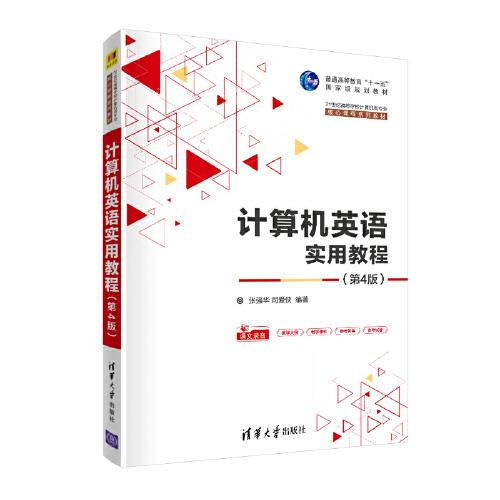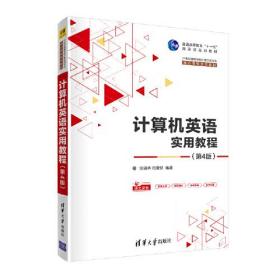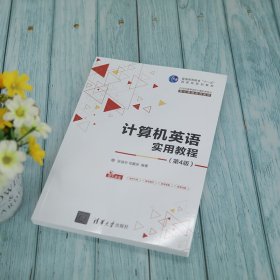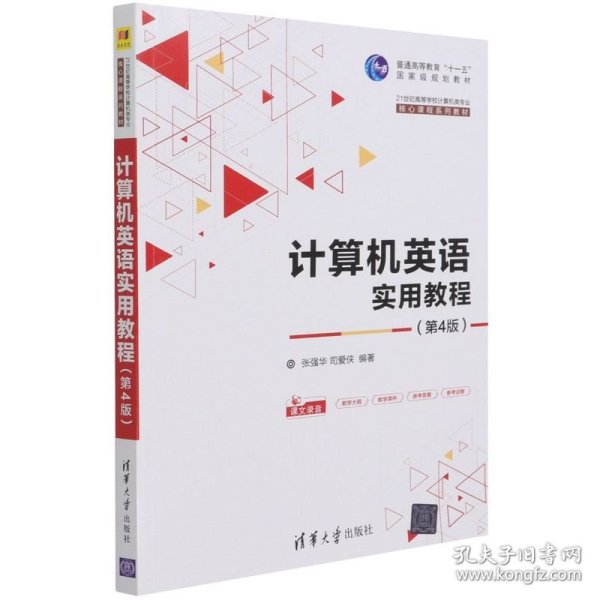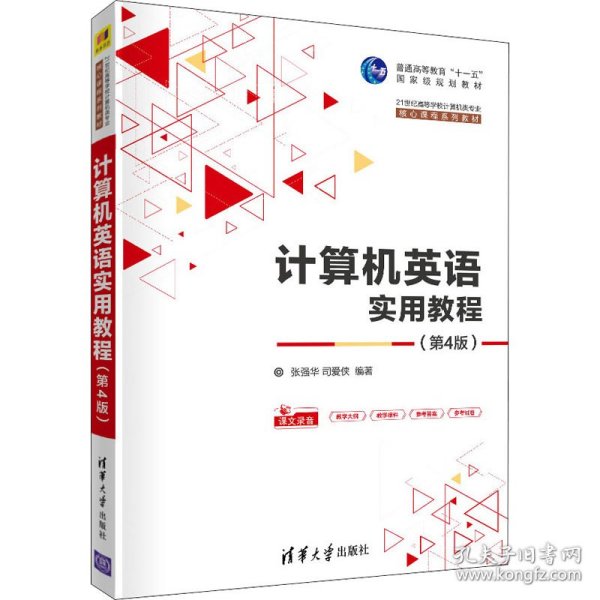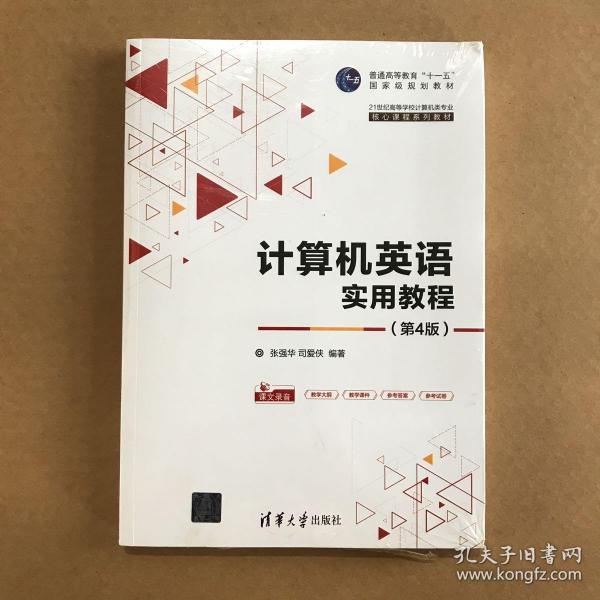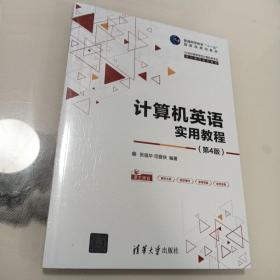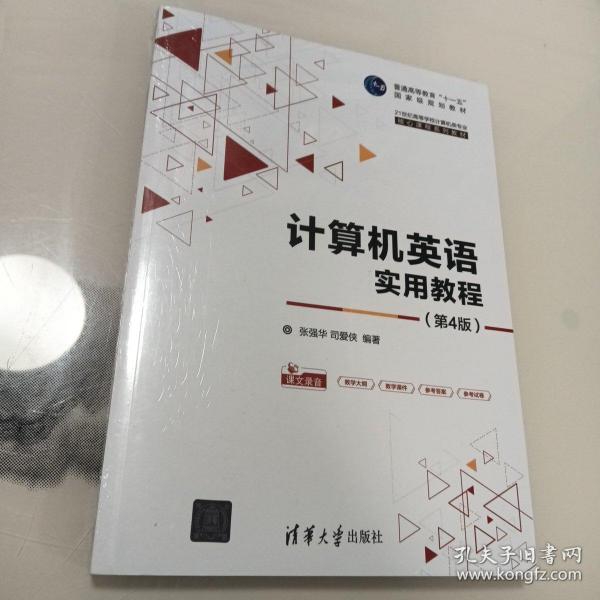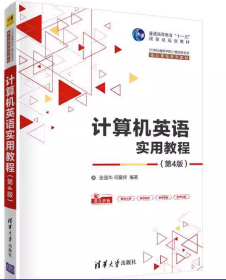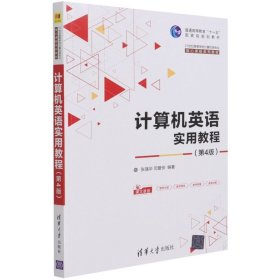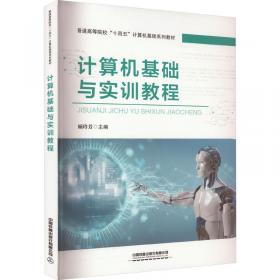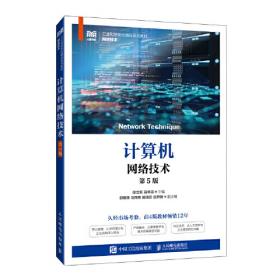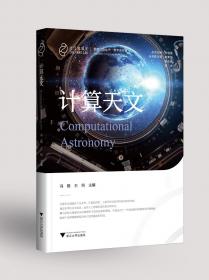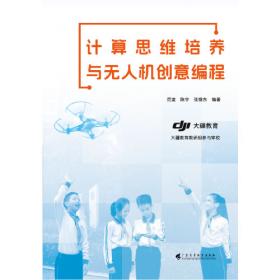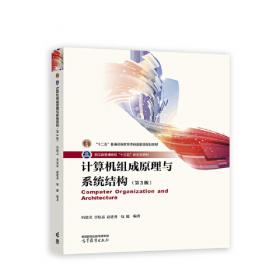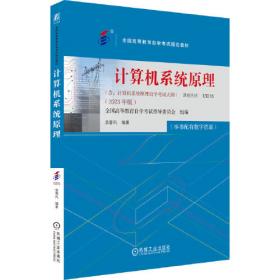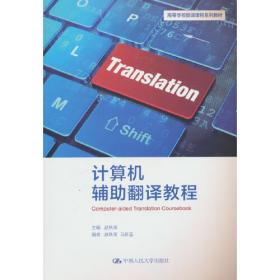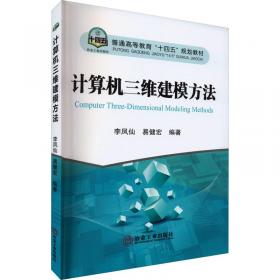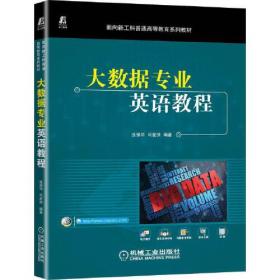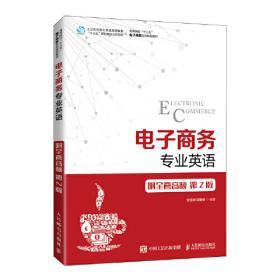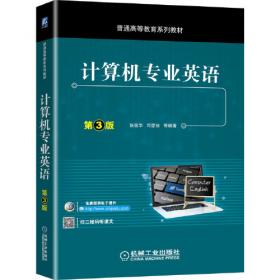计算机英语实用教程(第4版)
出版时间:
2021-07
版次:
4
ISBN:
9787302569725
定价:
49.80
装帧:
其他
开本:
16开
纸张:
胶版纸
字数:
434.000千字
19人买过
-
本书是面向职场而编写的计算机英语教材,力求切实提高读者实际使用行业英语的能力。内容切合行业实际,面向工作环境。以Unit为单位,每一Unit由以下几部分组成:课文——这些课文包括了计算机基础理论、主要应用领域、常用方法和新颖观念;单词——给出课文中出现的新词,读者由此可以积累专业基础词汇;词组——给出课文中的常用词组;缩略语——给出课文中出现的、业内人士必须掌握的缩略语;习题——巩固所学知识;阅读材料——提供计算机行业资料,进一步扩大读者的视野。 张强华,出版著作多部:计算机英语教程,北京,电子工业出版社:“全国第11批畅销书(科技类)”、江苏省优秀教材;计算机英语教程,北京:十一五规划教材;获“华东地区大学出版社教材专著二等奖” Unit 1 Computer Hardware 1
Text A Computer Hardware (1) 1
1. Introduction 1
2. Input Devices 1
3. Central Processing Unit (CPU) 3
4. Main Memory 4
New Words 5
Phrases 8
Abbreviations 9
Text A 参考译文 计算机硬件(1) 10
1. 引言 10
2. 输入设备 10
3. 中央处理器(CPU) 12
4. 主存 12
Text B Computer Hardware (2) 13
5. Secondary Storage Devices 13
6. Output Devices 15
New Words 17
Phrases 18
Abbreviations 19
Text B 参考译文 计算机硬件(2) 19
5. 辅助存储设备 19
6. 输出设备 21
Exercises 22
Online Resources 25
Unit 2 Software 26
Text A Different Types of Software 26
1. Application Software 26
2. System Software 27
3. Programming Software 27
4. Driver Software 28
5. Another Classification of Software 28
6. Conclusion 29
New Words 29
Phrases 31
Abbreviations 31
Text A 参考译文 软件的不同类型 32
1. 应用软件 32
2. 系统软件 32
3. 编程软件 33
4. 驱动程序软件 33
5. 另一种软件分类 33
6. 结论 34
Text B The Seven Phases of the System Development Life Cycle 34
1. Planning 35
2. Systems Analysis and Requirements 35
3. Systems Design 36
4. Development 36
5. Integration and Testing 36
6. Implementation 36
7. Operations and Maintenance 36
New Words 37
Phrases 39
Abbreviations 39
Text B 参考译文 系统开发生命周期的7个阶段 39
1. 规划 40
2. 系统分析与需求 40
3. 系统设计 40
4. 开发 40
5. 集成与测试 40
6. 实施 41
7. 运营与维护 41
Exercises 41
Online Resources 44
Unit 3 Operating System 45
Text A Operating System 45
1. Definition 45
2. Functions of Operating System 45
3. Types of Operating Systems 46
New Words 48
Phrases 50
Abbreviations 51
Text A 参考译文 操作系统 51
1. 定义 51
2. 操作系统的功能 52
3. 操作系统的类型 52
Text B What Is Linux 55
1. How Does Linux Differ from Other Operating Systems 55
2. What Is the Difference Between UNIX and Linux 55
3. Who Uses Linux 56
4. Who \"Owns\" Linux 56
5. How Was Linux Created 56
6. How Can I Contribute to Linux 56
7. How Can I Get Started Using Linux 57
New Words 57
Phrases 58
Abbreviations 59
Text B 参考译文 什么是Linux 59
1. Linux与其他操作系统有何不同 59
2. UNIX和Linux有什么区别 60
3. 谁使用Linux 60
4. 谁“拥有”Linux 60
5. Linux是如何创建的 60
6. 如何为Linux贡献力量 60
7. 如何开始使用Linux 61
Exercises 61
Online Resources 64
Unit 4 Data Structure and Algorithm 66
Text A Data Structure 66
1. Arrays 66
2. Stacks 67
3. Queues 67
4. Linked List 68
5. Graphs 69
6. Trees 70
7. Trie 71
8. Hash Table 72
New Words 72
Phrases 74
Abbreviations 76
Text A 参考译文 数据结构 76
1. 数组 76
2. 堆栈 77
3. 队列 77
4. 链表 78
5. 图 78
6. 树 79
7. 字典树 80
8. 哈希表 80
Text B Algorithm 81
1. Algorithm Design 81
2. Problem Development Steps 81
3. Characteristics of Algorithms 81
4. Pseudocode 82
5. The Need for Analysis 83
New Words 83
Phrases 84
Text B 参考译文 算法 85
1. 算法设计 85
2. 问题开发步骤 86
3. 算法特点 86
4. 伪代码 86
5. 分析需求 87
Exercises 88
Online Resources 91
Unit 5 Database and Data Warehousing 92
Text A Basic Concepts of Database 92
1. Database 92
2. Relational Database 92
3. SQL 93
4. Database Management System 93
5. Distributed Database 94
6. DDBMS 94
7. Field 94
8. Record 94
9. Table 95
New Words 95
Phrases 96
Abbreviations 96
Text A 参考译文 数据库基本概念 96
1. 数据库 96
2. 关系数据库 97
3. SQL 97
4. 数据库管理系统 98
5. 分布式数据库 98
6. DDBMS 98
7. 字段 98
8. 记录 99
9. 表 99
Text B Data Warehousing 99
1. What is Data Warehousing 99
2. How Does Data Warehouse Work 99
3. The Types of Data Warehouse 100
4. The General Stages of Data Warehouse 100
5. The Components of Data Warehouse 101
6. Who Needs Data Warehouse 101
7. The Steps to Implement Data Warehouse 101
8. The Advantages of Data Warehouse 102
9. The Disadvantages of Data Warehouse 102
10. The Future of Data Warehousing 103
New Words 103
Phrases 104
Abbreviations 104
Text B 参考译文 数据仓库 105
1. 什么是数据仓库 105
2. 数据仓库如何工作 105
3. 数据仓库的类型 105
4. 数据仓库的一般阶段 106
5. 数据仓库的组成 106
6. 谁需要数据仓库 107
7. 实施数据仓库的步骤 107
8. 数据仓库的优势 107
9. 数据仓库的缺点 108
10. 数据仓库的未来 108
Exercises 108
Online Resources 112
Unit 6 Object Oriented Design 113
Text A Object-Oriented Technology 113
1. Object-Oriented Analysis 113
2. Object-Oriented Design 113
3. Object-Oriented Programming 114
4. Objects and Classes 114
5. Encapsulation and Data Hiding 115
6. Message Passing 115
7. Inheritance 116
8. Polymorphism 116
9. Generalization and Specialization 117
New Words 117
Phrases 118
Abbreviations 119
Text A 参考译文 面向对象技术 119
1. 面向对象分析 119
2. 面向对象设计 120
3. 面向对象编程 120
4. 对象和类 121
5. 封装和数据隐藏 121
6. 消息传递 122
7. 继承 122
8. 多态性 123
9. 泛化与特化 123
Text B Computer Programmer 123
1. What Is a Computer Programmer 123
2. What Does a Computer Programmer Do 124
3. Types of Computer Programmers 125
New Words 128
Phrases 129
Abbreviations 130
Text B 参考译文 计算机程序员 130
1. 什么是计算机程序员 130
2. 计算机程序员做什么 131
3. 计算机程序员的类型 131
Exercises 134
Online Resources 137
Unit 7 Programming Languages 138
Text A Programming Language 138
1. Low-Level Languages 138
2. High-Level Languages 140
3. Differences Between Low Level Language and High Level Language 141
New Words 142
Phrases 143
Text A 参考译文 编程语言 144
1. 低级语言 144
2. 高级语言 145
3. 低级语言和高级语言之间的差异 146
Text B Python Programming Language 147
1. Features and Philosophy 148
2. Syntax and Semantics 148
3. Libraries 149
4. Development Environments 150
New Words 150
Phrases 152
Abbreviations 154
Text B 参考译文 Python编程语言 154
1. 特点和哲学 154
2. 句法和语义 154
3. 库 156
4. 开发环境 156
Exercises 157
Online Resources 160
Unit 8 Computer Network 161
Text A Computer Network Basic 161
1. What Is a Computer Network 161
2. Components of Computer Network 161
3. Uses of Computer Network 162
4. Computer Network Architecture 162
5. Features of Computer Network 163
6. Computer Network Types 164
New Words 166
Phrases 167
Abbreviations 168
Text A 参考译文 计算机网络基础 168
1. 什么是计算机网络 168
2. 计算机网络的组成部分 169
3. 计算机网络的用途 169
4. 计算机网络体系结构 170
5. 计算机网络的特点 171
6. 计算机网络类型 171
Text B Computer Network Topology 173
1. Bus Topology 173
2. Ring Topology 174
3. Star Topology 175
4. Tree Topology 175
5. Mesh Topology 176
6. Hybrid Topology 177
New Words 177
Phrases 178
Abbreviations 179
Text A 参考译文 计算机网络拓扑 179
1. 总线拓扑 179
2. 环形拓扑 180
3. 星形拓扑 180
4. 树形拓扑 181
5. 网状拓扑 182
6. 混合拓扑 182
Exercises 183
Online Resources 185
Unit 9 Network Security 186
Text A Network Security 186
1. Types of Network Attack 186
2. Components of Network Security 188
3. Security Technologies 189
New Words 190
Phrases 192
Abbreviations 192
Text A 参考译文 网络安全 193
1. 网络攻击的类型 193
2. 网络安全的组成部分 194
3. 安全技术 195
Text B Firewall 196
1. What Is a Firewall 196
2. Types of Firewalls 196
3. Firewall Configuration 198
New Words 200
Phrases 201
Abbreviations 201
Text B 参考译文 防火墙 202
1. 什么是防火墙 202
2. 防火墙的类型 202
3. 防火墙配置 204
Exercises 205
Online Resources 209
Unit 10 Cloud Computing and Cloud Storage 210
Text A Cloud Computing 210
1. What Is Cloud Computing 210
2. How Cloud Computing Works 211
3. Benefits of Cloud Computing 212
4 Risks of Cloud Computing 213
New Words 213
Phrases 214
Abbreviations 215
Text A 参考译文 云计算 215
1. 什么是云计算 215
2. 云计算如何工作 216
3. 云计算的好处 217
4. 云计算的风险 218
Text B Cloud Storage 218
1. What Is Cloud Storage 218
2. How Cloud Storage Works 219
3. Cloud Storage vs. Cloud Backup 219
4. How to Choose the Right Cloud Storage Provider 220
New Words 221
Phrases 222
Text B 参考译文 云存储 222
1. 什么是云存储 222
2. 云存储如何工作 222
3. 云存储与云备份 223
4. 如何选择合适的云存储提供商 224
Exercises 224
Online Resources 227
Unit 11 Big Data and Big Data Analytics 228
Text A Big Data 228
1. The Big Vs 228
2. More Contenders 229
3. An Example of Big Data 230
New Words 230
Phrases 232
Abbreviations 233
Text A 参考译文 大数据 233
1. 大V 234
2. 更多的属性 235
3. 一个大数据的示例 235
Text B Big Data Analytics 236
1. Big Data Requires High Performance Analytics 236
2. The Challenges of Big Data Analytics 236
3. How Big Data Analytics is Used Today 236
4. The Benefits of Big Data Analytics 237
5. Top 10 Hot Big Data Technologies 237
New Words 238
Phrases 239
Abbreviations 240
Text B 参考译文 大数据分析 240
1. 大数据需要高性能分析 240
2. 大数据分析的挑战 240
3. 如今如何使用大数据分析 240
4. 大数据分析的好处 241
5. 十大热门大数据技术 241
Exercises 242
Online Resources 245
Unit 12 Artificial Intelligence 246
Text A Artificial Intelligence (AI) 246
1. Types of AI 247
2. Examples of AI Technology 247
3. AI Applications 248
4. Security and Ethical Concerns 249
5. Regulation of AI Technology 249
New Words 250
Phrases 252
Abbreviations 253
Text A 参考译文 人工智能 254
1. 人工智能的类型 254
2. 人工智能技术的例子 255
3. 人工智能应用 256
4. 安全和伦理问题 256
5. 人工智能技术的规范 257
Text B What Is Machine Learning 257
1. What Is Machine Learning 257
2. Why Do We Need Machine Learning 258
3. How Do Machines Learn 258
4. Steps in Machine Learning 260
5. Applications of Machine Learning 261
New Words 261
Phrases 262
Abbreviations 262
Text B 参考译文 什么是机器学习 262
1. 什么是机器学习 263
2. 为什么需要机器学习 263
3. 机器如何学习 263
4. 机器学习的步骤 264
5. 机器学习的应用 265
Exercises 266
Online Resources 269
-
内容简介:
本书是面向职场而编写的计算机英语教材,力求切实提高读者实际使用行业英语的能力。内容切合行业实际,面向工作环境。以Unit为单位,每一Unit由以下几部分组成:课文——这些课文包括了计算机基础理论、主要应用领域、常用方法和新颖观念;单词——给出课文中出现的新词,读者由此可以积累专业基础词汇;词组——给出课文中的常用词组;缩略语——给出课文中出现的、业内人士必须掌握的缩略语;习题——巩固所学知识;阅读材料——提供计算机行业资料,进一步扩大读者的视野。
-
作者简介:
张强华,出版著作多部:计算机英语教程,北京,电子工业出版社:“全国第11批畅销书(科技类)”、江苏省优秀教材;计算机英语教程,北京:十一五规划教材;获“华东地区大学出版社教材专著二等奖”
-
目录:
Unit 1 Computer Hardware 1
Text A Computer Hardware (1) 1
1. Introduction 1
2. Input Devices 1
3. Central Processing Unit (CPU) 3
4. Main Memory 4
New Words 5
Phrases 8
Abbreviations 9
Text A 参考译文 计算机硬件(1) 10
1. 引言 10
2. 输入设备 10
3. 中央处理器(CPU) 12
4. 主存 12
Text B Computer Hardware (2) 13
5. Secondary Storage Devices 13
6. Output Devices 15
New Words 17
Phrases 18
Abbreviations 19
Text B 参考译文 计算机硬件(2) 19
5. 辅助存储设备 19
6. 输出设备 21
Exercises 22
Online Resources 25
Unit 2 Software 26
Text A Different Types of Software 26
1. Application Software 26
2. System Software 27
3. Programming Software 27
4. Driver Software 28
5. Another Classification of Software 28
6. Conclusion 29
New Words 29
Phrases 31
Abbreviations 31
Text A 参考译文 软件的不同类型 32
1. 应用软件 32
2. 系统软件 32
3. 编程软件 33
4. 驱动程序软件 33
5. 另一种软件分类 33
6. 结论 34
Text B The Seven Phases of the System Development Life Cycle 34
1. Planning 35
2. Systems Analysis and Requirements 35
3. Systems Design 36
4. Development 36
5. Integration and Testing 36
6. Implementation 36
7. Operations and Maintenance 36
New Words 37
Phrases 39
Abbreviations 39
Text B 参考译文 系统开发生命周期的7个阶段 39
1. 规划 40
2. 系统分析与需求 40
3. 系统设计 40
4. 开发 40
5. 集成与测试 40
6. 实施 41
7. 运营与维护 41
Exercises 41
Online Resources 44
Unit 3 Operating System 45
Text A Operating System 45
1. Definition 45
2. Functions of Operating System 45
3. Types of Operating Systems 46
New Words 48
Phrases 50
Abbreviations 51
Text A 参考译文 操作系统 51
1. 定义 51
2. 操作系统的功能 52
3. 操作系统的类型 52
Text B What Is Linux 55
1. How Does Linux Differ from Other Operating Systems 55
2. What Is the Difference Between UNIX and Linux 55
3. Who Uses Linux 56
4. Who \"Owns\" Linux 56
5. How Was Linux Created 56
6. How Can I Contribute to Linux 56
7. How Can I Get Started Using Linux 57
New Words 57
Phrases 58
Abbreviations 59
Text B 参考译文 什么是Linux 59
1. Linux与其他操作系统有何不同 59
2. UNIX和Linux有什么区别 60
3. 谁使用Linux 60
4. 谁“拥有”Linux 60
5. Linux是如何创建的 60
6. 如何为Linux贡献力量 60
7. 如何开始使用Linux 61
Exercises 61
Online Resources 64
Unit 4 Data Structure and Algorithm 66
Text A Data Structure 66
1. Arrays 66
2. Stacks 67
3. Queues 67
4. Linked List 68
5. Graphs 69
6. Trees 70
7. Trie 71
8. Hash Table 72
New Words 72
Phrases 74
Abbreviations 76
Text A 参考译文 数据结构 76
1. 数组 76
2. 堆栈 77
3. 队列 77
4. 链表 78
5. 图 78
6. 树 79
7. 字典树 80
8. 哈希表 80
Text B Algorithm 81
1. Algorithm Design 81
2. Problem Development Steps 81
3. Characteristics of Algorithms 81
4. Pseudocode 82
5. The Need for Analysis 83
New Words 83
Phrases 84
Text B 参考译文 算法 85
1. 算法设计 85
2. 问题开发步骤 86
3. 算法特点 86
4. 伪代码 86
5. 分析需求 87
Exercises 88
Online Resources 91
Unit 5 Database and Data Warehousing 92
Text A Basic Concepts of Database 92
1. Database 92
2. Relational Database 92
3. SQL 93
4. Database Management System 93
5. Distributed Database 94
6. DDBMS 94
7. Field 94
8. Record 94
9. Table 95
New Words 95
Phrases 96
Abbreviations 96
Text A 参考译文 数据库基本概念 96
1. 数据库 96
2. 关系数据库 97
3. SQL 97
4. 数据库管理系统 98
5. 分布式数据库 98
6. DDBMS 98
7. 字段 98
8. 记录 99
9. 表 99
Text B Data Warehousing 99
1. What is Data Warehousing 99
2. How Does Data Warehouse Work 99
3. The Types of Data Warehouse 100
4. The General Stages of Data Warehouse 100
5. The Components of Data Warehouse 101
6. Who Needs Data Warehouse 101
7. The Steps to Implement Data Warehouse 101
8. The Advantages of Data Warehouse 102
9. The Disadvantages of Data Warehouse 102
10. The Future of Data Warehousing 103
New Words 103
Phrases 104
Abbreviations 104
Text B 参考译文 数据仓库 105
1. 什么是数据仓库 105
2. 数据仓库如何工作 105
3. 数据仓库的类型 105
4. 数据仓库的一般阶段 106
5. 数据仓库的组成 106
6. 谁需要数据仓库 107
7. 实施数据仓库的步骤 107
8. 数据仓库的优势 107
9. 数据仓库的缺点 108
10. 数据仓库的未来 108
Exercises 108
Online Resources 112
Unit 6 Object Oriented Design 113
Text A Object-Oriented Technology 113
1. Object-Oriented Analysis 113
2. Object-Oriented Design 113
3. Object-Oriented Programming 114
4. Objects and Classes 114
5. Encapsulation and Data Hiding 115
6. Message Passing 115
7. Inheritance 116
8. Polymorphism 116
9. Generalization and Specialization 117
New Words 117
Phrases 118
Abbreviations 119
Text A 参考译文 面向对象技术 119
1. 面向对象分析 119
2. 面向对象设计 120
3. 面向对象编程 120
4. 对象和类 121
5. 封装和数据隐藏 121
6. 消息传递 122
7. 继承 122
8. 多态性 123
9. 泛化与特化 123
Text B Computer Programmer 123
1. What Is a Computer Programmer 123
2. What Does a Computer Programmer Do 124
3. Types of Computer Programmers 125
New Words 128
Phrases 129
Abbreviations 130
Text B 参考译文 计算机程序员 130
1. 什么是计算机程序员 130
2. 计算机程序员做什么 131
3. 计算机程序员的类型 131
Exercises 134
Online Resources 137
Unit 7 Programming Languages 138
Text A Programming Language 138
1. Low-Level Languages 138
2. High-Level Languages 140
3. Differences Between Low Level Language and High Level Language 141
New Words 142
Phrases 143
Text A 参考译文 编程语言 144
1. 低级语言 144
2. 高级语言 145
3. 低级语言和高级语言之间的差异 146
Text B Python Programming Language 147
1. Features and Philosophy 148
2. Syntax and Semantics 148
3. Libraries 149
4. Development Environments 150
New Words 150
Phrases 152
Abbreviations 154
Text B 参考译文 Python编程语言 154
1. 特点和哲学 154
2. 句法和语义 154
3. 库 156
4. 开发环境 156
Exercises 157
Online Resources 160
Unit 8 Computer Network 161
Text A Computer Network Basic 161
1. What Is a Computer Network 161
2. Components of Computer Network 161
3. Uses of Computer Network 162
4. Computer Network Architecture 162
5. Features of Computer Network 163
6. Computer Network Types 164
New Words 166
Phrases 167
Abbreviations 168
Text A 参考译文 计算机网络基础 168
1. 什么是计算机网络 168
2. 计算机网络的组成部分 169
3. 计算机网络的用途 169
4. 计算机网络体系结构 170
5. 计算机网络的特点 171
6. 计算机网络类型 171
Text B Computer Network Topology 173
1. Bus Topology 173
2. Ring Topology 174
3. Star Topology 175
4. Tree Topology 175
5. Mesh Topology 176
6. Hybrid Topology 177
New Words 177
Phrases 178
Abbreviations 179
Text A 参考译文 计算机网络拓扑 179
1. 总线拓扑 179
2. 环形拓扑 180
3. 星形拓扑 180
4. 树形拓扑 181
5. 网状拓扑 182
6. 混合拓扑 182
Exercises 183
Online Resources 185
Unit 9 Network Security 186
Text A Network Security 186
1. Types of Network Attack 186
2. Components of Network Security 188
3. Security Technologies 189
New Words 190
Phrases 192
Abbreviations 192
Text A 参考译文 网络安全 193
1. 网络攻击的类型 193
2. 网络安全的组成部分 194
3. 安全技术 195
Text B Firewall 196
1. What Is a Firewall 196
2. Types of Firewalls 196
3. Firewall Configuration 198
New Words 200
Phrases 201
Abbreviations 201
Text B 参考译文 防火墙 202
1. 什么是防火墙 202
2. 防火墙的类型 202
3. 防火墙配置 204
Exercises 205
Online Resources 209
Unit 10 Cloud Computing and Cloud Storage 210
Text A Cloud Computing 210
1. What Is Cloud Computing 210
2. How Cloud Computing Works 211
3. Benefits of Cloud Computing 212
4 Risks of Cloud Computing 213
New Words 213
Phrases 214
Abbreviations 215
Text A 参考译文 云计算 215
1. 什么是云计算 215
2. 云计算如何工作 216
3. 云计算的好处 217
4. 云计算的风险 218
Text B Cloud Storage 218
1. What Is Cloud Storage 218
2. How Cloud Storage Works 219
3. Cloud Storage vs. Cloud Backup 219
4. How to Choose the Right Cloud Storage Provider 220
New Words 221
Phrases 222
Text B 参考译文 云存储 222
1. 什么是云存储 222
2. 云存储如何工作 222
3. 云存储与云备份 223
4. 如何选择合适的云存储提供商 224
Exercises 224
Online Resources 227
Unit 11 Big Data and Big Data Analytics 228
Text A Big Data 228
1. The Big Vs 228
2. More Contenders 229
3. An Example of Big Data 230
New Words 230
Phrases 232
Abbreviations 233
Text A 参考译文 大数据 233
1. 大V 234
2. 更多的属性 235
3. 一个大数据的示例 235
Text B Big Data Analytics 236
1. Big Data Requires High Performance Analytics 236
2. The Challenges of Big Data Analytics 236
3. How Big Data Analytics is Used Today 236
4. The Benefits of Big Data Analytics 237
5. Top 10 Hot Big Data Technologies 237
New Words 238
Phrases 239
Abbreviations 240
Text B 参考译文 大数据分析 240
1. 大数据需要高性能分析 240
2. 大数据分析的挑战 240
3. 如今如何使用大数据分析 240
4. 大数据分析的好处 241
5. 十大热门大数据技术 241
Exercises 242
Online Resources 245
Unit 12 Artificial Intelligence 246
Text A Artificial Intelligence (AI) 246
1. Types of AI 247
2. Examples of AI Technology 247
3. AI Applications 248
4. Security and Ethical Concerns 249
5. Regulation of AI Technology 249
New Words 250
Phrases 252
Abbreviations 253
Text A 参考译文 人工智能 254
1. 人工智能的类型 254
2. 人工智能技术的例子 255
3. 人工智能应用 256
4. 安全和伦理问题 256
5. 人工智能技术的规范 257
Text B What Is Machine Learning 257
1. What Is Machine Learning 257
2. Why Do We Need Machine Learning 258
3. How Do Machines Learn 258
4. Steps in Machine Learning 260
5. Applications of Machine Learning 261
New Words 261
Phrases 262
Abbreviations 262
Text B 参考译文 什么是机器学习 262
1. 什么是机器学习 263
2. 为什么需要机器学习 263
3. 机器如何学习 263
4. 机器学习的步骤 264
5. 机器学习的应用 265
Exercises 266
Online Resources 269
查看详情
-
八五品
河南省鹤壁市
平均发货22小时
成功完成率90.9%
-
计算机英语实用教程(第4版)
买书,就上二手书海官方企业店,清仓处理,真实库存,特价正版,收藏店铺,优先发货! ps:下午三点之前的订单当天发货,之后明天发货,特殊情况除外。
八五品
河南省鹤壁市
平均发货28小时
成功完成率88.69%
-
全新
河北省保定市
平均发货20小时
成功完成率73.25%
-
全新
河北省保定市
平均发货24小时
成功完成率92.51%
-
全新
江苏省无锡市
平均发货25小时
成功完成率87.66%
-
全新
广东省广州市
平均发货20小时
成功完成率86.47%
-
全新
四川省成都市
平均发货61小时
成功完成率83.3%
-
全新
河北省保定市
平均发货24小时
成功完成率79.23%
-
全新
江苏省南京市
平均发货8小时
成功完成率96.65%
-
八五品
重庆市沙坪坝区
平均发货14小时
成功完成率90%
-
八五品
四川省成都市
平均发货12小时
成功完成率91.65%
-
八五品
山西省临汾市
平均发货15小时
成功完成率78.21%
-
全新
北京市朝阳区
平均发货19小时
成功完成率94.9%
-
全新
北京市朝阳区
平均发货17小时
成功完成率96.19%
-
全新
北京市朝阳区
平均发货17小时
成功完成率96.19%
-
九五品
江西省南昌市
平均发货19小时
成功完成率85.05%
-
全新
河北省保定市
平均发货23小时
成功完成率90.59%
-
全新
河北省保定市
平均发货24小时
成功完成率90.38%
-
全新
北京市朝阳区
平均发货19小时
成功完成率94.9%
-
九品
江西省南昌市
平均发货17小时
成功完成率85.23%
-
全新
河北省保定市
平均发货20小时
成功完成率86.81%
-
全新
北京市丰台区
平均发货27小时
成功完成率91.37%
-
全新
北京市丰台区
平均发货23小时
成功完成率88.57%
-
全新
江苏省苏州市
平均发货9小时
成功完成率95.75%
-
全新
北京市西城区
平均发货29小时
成功完成率90.38%
-
八五品
广西南宁市
平均发货7小时
成功完成率88.01%
-
全新
北京市海淀区
平均发货15小时
成功完成率89.62%
-
全新
四川省成都市
平均发货28小时
成功完成率85.64%
-
全新
天津市西青区
平均发货14小时
成功完成率90.42%
-
全新
江苏省无锡市
平均发货25小时
成功完成率87.66%
-
全新
河北省保定市
平均发货26小时
成功完成率91.98%
-
全新
河北省保定市
平均发货26小时
成功完成率89.65%
-
全新
河北省保定市
平均发货17小时
成功完成率82.71%
-
正版现货 计算机英语实用教程(第4版)
大中专理科计算机 1、“重量”规划教材的近期新升级版; 2、线上线下资源整合的立体化教材; 3、扫码即可听课文的有声教材; 4、完整的教学支持体系(教学课件、教学大纲、参考答案、参考试卷);5、有25年编写经验的作者团队精心打造; 新华书店全新正版书籍
全新
北京市东城区
平均发货30小时
成功完成率83.91%
-
八五品
山西省晋中市
平均发货7小时
成功完成率88.4%
-
计算机英语实用教程(第4版)
大中专理科计算机 1、“重量”规划教材的近期新升级版; 2、线上线下资源整合的立体化教材; 3、扫码即可听课文的有声教材; 4、完整的教学支持体系(教学课件、教学大纲、参考答案、参考试卷);5、有25年编写经验的作者团队精心打造; 新华书店全新正版书籍
全新
江苏省无锡市
平均发货8小时
成功完成率95.83%
-
全新
江苏省无锡市
平均发货25小时
成功完成率87.66%
-
全新
河北省保定市
平均发货15小时
成功完成率91.13%
-
全新
江苏省无锡市
平均发货10小时
成功完成率92.91%
-
全新
北京市朝阳区
平均发货9小时
成功完成率96.79%
-
全新
江苏省无锡市
平均发货18小时
成功完成率92.29%
-
全新
天津市河东区
平均发货29小时
成功完成率90.01%
-
全新
江苏省无锡市
平均发货18小时
成功完成率94.47%
-
全新
天津市西青区
平均发货22小时
成功完成率93.91%
-
九五品
河南省信阳市
平均发货11小时
成功完成率95.4%
-
九五品
河南省信阳市
平均发货11小时
成功完成率95.4%
-
全新
陕西省西安市
平均发货18小时
成功完成率95.45%
-
九品
陕西省西安市
平均发货18小时
成功完成率95.45%
-
八五品
江西省南昌市
平均发货11小时
成功完成率92.26%
-
全新
河北省保定市
平均发货15小时
成功完成率82.17%

 占位居中
占位居中

